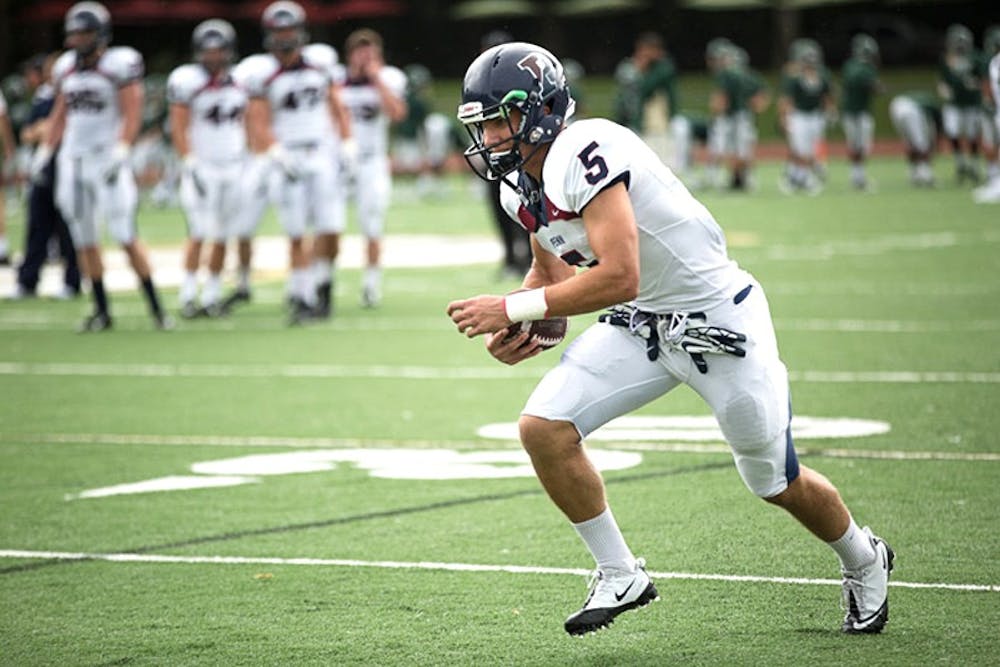Anyone who says numbers never lie didn’t watch Penn’s offense last season.
A year ago, then-sophomore quarterback Alek Torgersen was near the top of not only the Ivy League, but the entire Football Championship Subdivision in multiple passing categories. The Huntington Beach, Calif., native was third in the nation, averaging 26 completions a contest. He was also 11th in the country and second in the Ivy League with 268.9 passing yards per game.
Despite this, however, the Red and Blue's offense was at many points anemic, only managing enough consistency to collect two victories. In fact, the Quakers finished sixth in the Ivy League last year with 213 points scored — a mark nearly half that of league-leading Yale.
Now, after losing Conner Scott, one of the Quakers’ all-time great receivers, and tight end Mitch King to graduation, it’s time for Torgersen and a handful of other veterans to carry the torch and become consistent playmakers.
New offensive coordinator John Reagan has implemented his version of the spread offense, which is nothing new for the Red and Blue. But the squad will have to break from its seemingly never-ending supply of two-yard screen passes if is going to start doing any serious damage.
Gutsier play calling and fewer passing attempts — Torgersen set a school record with 421 last season — could do wonders for the Red and Blue. After all, Torgersen is a 6-foot-3 gunslinger with a big arm, and it’s time Penn utilized it more consistently. Football is a game of inches, but you can’t march down the field one inch at a time.
When the Quakers last won the Ivy League title in 2012, there was significantly more of a balance within the team's offense. Billy Ragone was a dual-threat quarterback who forced opposing defenses to stay on their toes. Defenders couldn’t sit on bubble screens or slant routes, thereby allowing big plays to develop.
While Torgersen may not have the same hybrid quarterback skill set as Ragone, he can move around in the pocket and scramble when necessary. But establishing a consistent running game with its backfield could be just as successful for Penn.
Last season, the Quakers' top three running backs on the depth chart were all injured by end of the team's Oct. 11 contest at Fordham, leaving the backfield depleted of options. In turn, without a consistent ground game, defenses were able to sit on the pass without much risk of anyone on Penn’s roster bursting through the middle for a big gain.
Now, heading into 2015, the pressure rests on sophomore Tre Solomon to flip the script and force defenders to respect the run. After tearing his ACL against the Rams, Solomon has been working towards establishing himself as the Quakers' every-down back, and, at 6-foot, 200 pounds, the Brooklyn, N.Y., native has the size and power to be a legitimate threat in Ivy play.
In his brief stint on the field as a rookie, Solomon was productive, accumulating 145 yards while averaging 5.8 yards per carry. If he could stretch that small sample size out consistently over an entire season, the Red and Blue may have just the one-two punch they need between him and Torgersen.
But if Penn is going to make its offensive opportunities count in 2015, it will need to solve a factor equally as problematic as last season's dearth of a run game and lack of explosiveness: ineffectiveness in the red zone.
In no contest was the Quakers' futility so apparent as their matchup against Fordham. That game saw Penn play so poorly inside the 20 that kicker Jimmy Gammil set a school record with five field goals, including four on failed trips to the redzone.
On top of an improved rushing attack and more calculated throws, one solution for the Quakers may be to try and effectively utilize veteran tight ends Ryan O’Malley and Ryan Kelly. The two seniors are huge targets and often pose significant mismatches for opposing secondaries. Connecting with them could yield big dividends close to the endzone.
Undoubtedly, the problem for Penn is not any one player, nor is the solution. But the Quakers have the talent to improve on their 2014 showing; now it’s time to put it all together and hope for the best.









